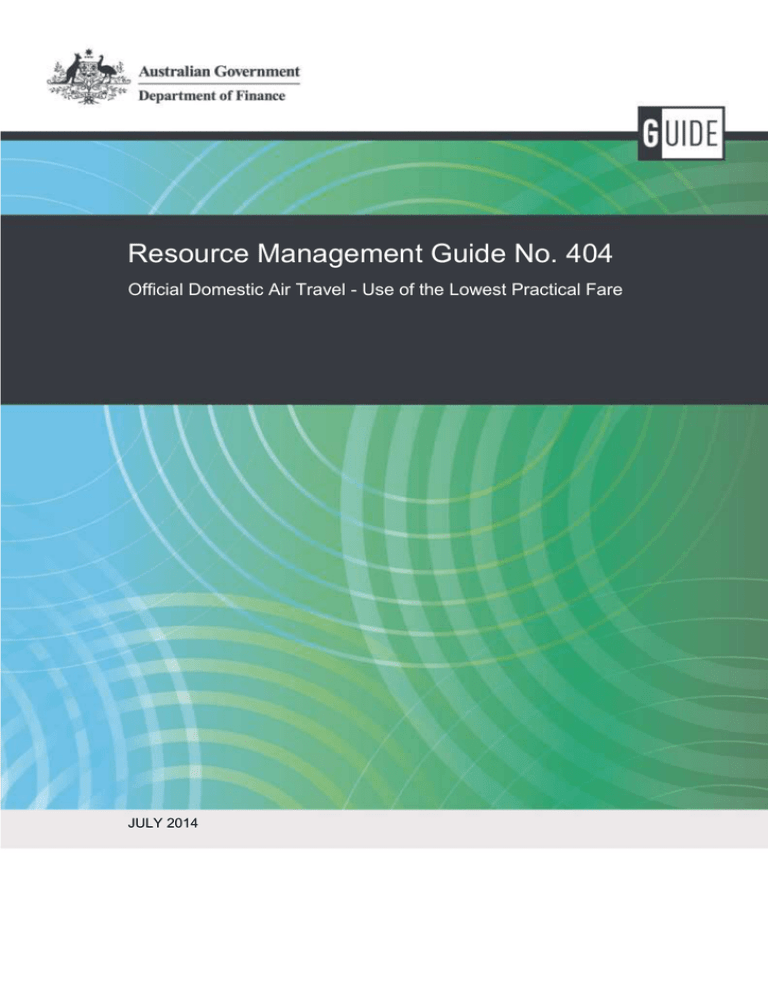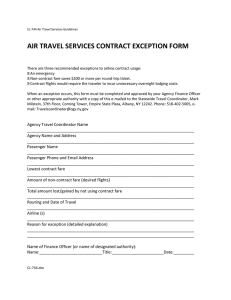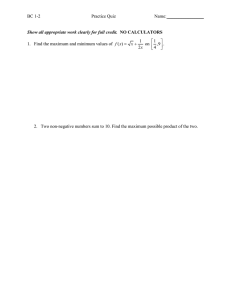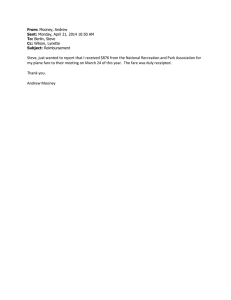Resource Management Guide No. 404 JULY 2014
advertisement

Resource Management Guide No. 404 Official Domestic Air Travel - Use of the Lowest Practical Fare JULY 2014 © Commonwealth of Australia 2014 ISBN: 978-1-922096-73-9 (Online) With the exception of the Commonwealth Coat of Arms and where otherwise noted, all material presented in this document is provided under a Creative Commons Attribution 3.0 Australia (http://creativecommons.org/licenses/by/3.0/au) licence. The details of the relevant licence conditions are available on the Creative Commons website (accessible using the links provided) as is the full legal code for the CC BY 3 AU licence. Use of the Coat of Arms The terms under which the Coat of Arms can be used are detailed on the following website: www.itsanhonour.gov.au/coat-arms. Contact us Questions or comments about this guide should be directed to: Public Management Reform Agenda Department of Finance John Gorton Building King Edward Terrace Parkes ACT 2600 Email: pmra@finance.gov.au Internet: www.pmra.finance.gov.au This guide contains material that has been prepared to assist Commonwealth entities and companies to apply the principles and requirements of the Public Governance, Performance and Accountability Act 2013 and associated rules, and any applicable policies. In this guide the: mandatory principles or requirements are set out as things entities and officials ‘must’ do; and actions, or practices, that entities and officials are expected to take into account to give effect to those and principles and/or requirements are set out as things entities and officials ‘should consider’ doing. Contents AUDIENCE .............................................................................................................................................................. 2 KEY POINTS............................................................................................................................................................. 2 RESOURCES ............................................................................................................................................................ 2 POLICY .................................................................................................................................................................. 2 GUIDANCE.............................................................................................................................................................. 2 Key considerations .......................................................................................................................................... 2 Applying the Lowest Practical Fare Policy ...................................................................................................... 3 Lowest Practical Fare Policy Booking Codes ................................................................................................... 3 Booking considerations .................................................................................................................................. 4 Monitoring compliance .................................................................................................................................. 4 Resource Management Guide 404 Official Domestic Air Travel | 1 Audience This Guide applies to: all Non-corporate Commonwealth Entities. Corporate Commonwealth Entities are encouraged to comply with this Guide. Key points This Guide: Sets out entity requirements for achieving value for money when selecting, booking and approving official domestic air travel. Takes effect from 1 July 2014. Replaces Finance Circular 2012/04: Use of the Lowest Practical Fare for Official Domestic Air Travel. Resources This Guide is available on the Department of Finance website at www.finance.gov.au For any queries regarding this Guide, please contact the Travel Contract Management Section at TCMS@finance.gov.au Policy 1. When undertaking official domestic air travel, officials should select the Lowest Practical Fare (LPF), which is the lowest fare available at the time the travel is booked on a regular service (not a charter flight), that suits the practical business needs of the traveller. Guidance Key considerations 2. Value for Money: Value for money is the overarching consideration when booking flights for domestic air travel. Value for money requires the use of Commonwealth resources in an efficient, effective, economical and ethical manner that is not inconsistent with policies of the Commonwealth, and is enhanced through competition. Accordingly, when booking travel, officials must make decisions based on an impartial consideration of the fares available and not on a personal preference for a particular airline or aircraft type, access to airline lounges or accumulating airline reward and loyalty points (including status credits). 3. Necessity of Travel: Air travel should only be undertaken where other communication tools, such as teleconferencing and videoconferencing, are ineffective. In approving travel, the approver (the official approving domestic air travel) should be satisfied that there is a demonstrated business need for the travel. 4. Diligence: Officials must act in accordance with the internal travel policies of their entity and with the Australian Public Service Code of Conduct. This includes acting reasonably in scheduling meetings or other events for which travel is considered necessary (e.g. minimising unnecessary travel time). Resource Management Guide 404 Official Domestic Air Travel | 2 Applying the Lowest Practical Fare Policy 5. Officials should make two key decisions when selecting a fare for travel: a) Fare class: All air travel should be the lowest practical fare in economy class unless there is a business case or entitlement to travel business class. Should the approver approve business class travel where there is no entitlement, the reasons for travel in that class must be documented in each instance. b) Fare type: Where there is a high degree of certainty for required arrival or departure times, officials should assess all fares and consider restricted fare types. Where there is a possibility that a scheduled meeting will not proceed, or there is uncertainty around the time that a scheduled meeting may conclude, officials should consider whether the additional cost of flexible fares outweighs the cost of possible changes or cancellation fees. 6. Officials should compare fare classes and types across airlines servicing the particular route required. Each leg (outbound and inbound) should be considered separately. Lowest Practical Fare Policy Booking Codes 7. When booking official domestic air travel, officials must identify the reason a fare is selected using the LPF Policy booking codes at Table 1 below. These include a code when the lowest practical fare is not selected. Table 1 - Lowest Practical Fare Policy Booking Codes No Booking Code Map to LPF guidance 1 Lowest fare This is the cheapest available fare taking into account the 45 minute window (refer to paragraphs 12 to 14). 2 Timing, routing, connection or baggage charges Where the fare selected is not the lowest fare because it: Approval / Entitlement to travel at higher fare class (e.g. business class or premium economy) All air travel should be at the lowest practical fare in economy class unless there is a business case or entitlement to travel outside these guidelines. 4 Health issues Health issues for officials requiring certain facilities. A medical certificate should support use of this code. 5 Personal responsibilities Impact on personal responsibilities such as family. 6 Require flexibility to Where flexibility is required for air travel, travel bookers should change booking consider selecting a semi-flexible fare type instead of a fully flexible fare. 7 Outside of LPF Policy 3 is the most direct route; ensures connections for further flights are met; or takes into account excess baggage fees. In these circumstances, officials are still required to obtain the lowest practical fare within the entitlement. Preference for particular aircraft or airlines, availability of access to airline lounges, accumulation of airline benefits such as reward or loyalty points (including status credits). Resource Management Guide 404 Official Domestic Air Travel | 3 Booking considerations 8. Unused credits: Where airfare credits exist, these should be used for subsequent travel bookings to help reduce the fare cost where possible. 9. Lounge memberships: The ability to access an airline lounge is not to be considered in applying the LPF Policy. 10. Reward and loyalty points (including status credits): The implementation of the Whole of Australian Government Travel Arrangements (Travel Arrangements) on 1 July 2010 ceased the accrual of reward and loyalty points (such as frequent flyer points). Where officials have retained previously accrued reward and loyalty points, these should be used to reduce the cost of future flights required for official travel. It is Government policy that such points, where awarded for official air travel, are not to be used for private purposes or to upgrade the class of official air travel. Monitoring compliance 11. Entities are to manage compliance with this LPF Policy in accordance with the entity’s internal processes. 12. To assist entities in reporting against the LPF Policy internally, the Travel Management Companies (TMCs) contracted under the Travel Arrangements use a 45 minute 'time window' to monitor whether the lowest practical fare has been selected, and assess potential missed savings. This reporting is available to entities through their TMC. 13. For outbound flights, the window commences 45 minutes prior to the booked flight time. For example, an official based in Canberra is required to attend a meeting in Sydney at 10.30am. The official determines that the latest possible departure time from Canberra is 9.00am and books a flight at 8.50am. The 45 minute window the TMC uses to compare flights starts at 8.05am and ends at 8.50am. Therefore, if the flight to Sydney at 8.50am on airline A cost $200 and a flight to Sydney at 8.30am on airline B cost $150, the lowest practical fare is on airline B at 8.30am and the TMC will report missed savings of $50 to the official's entity. 14. For inbound flights the window commences 45 minutes after the booked flight time. For example, an official is returning to Canberra after a meeting in Sydney that is scheduled to conclude at 2.00pm. The official determines that the earliest possible departure time is 3.30pm and books a flight at 3.40pm. The 45 minute window the TMC uses to compare flights starts at 3.40pm and ends at 4.25pm. Therefore, if the flight to Canberra at 3.40pm on airline A cost $200 and a flight to Canberra at 4.10pm on airline B cost $150, the lowest practical fare is on airline B at 4.10pm and the TMC will report missed savings of $50 to the official's entity. Resource Management Guide 404 Official Domestic Air Travel | 4



